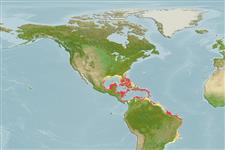>
Ovalentaria/misc (Various families in series Ovalentaria) >
Pomacentridae (Damselfishes) > Microspathodontinae
Etymology: Microspathodon: Greek, mikros = small + Greek, spatha = spathe + Greek, odous = teeth (Ref. 45335).
More on author: Cuvier.
Environment: milieu / climate zone / depth range / distribution range
Ökologie
seewasser riff-verbunden; standorttreu; tiefenbereich 0 - 120 m (Ref. 10797), usually 0 - 10 m (Ref. 7247). Subtropical; 33°N - 25°S, 98°W - 34°W
Western Atlantic: southern Florida (USA) and Bermuda through the Caribbean Sea to Brazil (Ref. 40101).
Size / Gewicht / Alter
Maturity: Lm ? range ? - ? cm
Max length : 21.0 cm TL Männchen/unbestimmt; (Ref. 9710); common length : 15.0 cm TL Männchen/unbestimmt; (Ref. 3139)
Rückenflossenstacheln (insgesamt): 12; Rückenflossenweichstrahlen (insgesamt): 14-15; Afterflossenstacheln 2; Afterflossenweichstrahlen: 12 - 13. Tail bright yellow. Juveniles dark blue with transparent tail and electric blue spots on side (Ref. 26938). Adults dark yellowish brown, the edges of the scales darker (Ref 13442).
A common (Ref. 9710) territorial species that inhabits coral reefs, juveniles usually encountered among branches of yellow stinging coral, Millepora. Adults are found in very shallow waters of coral reefs, usually near top of outer edge where there are caves, holes, and abundant fire coral (Ref. 26938). Feed primarily on algae but also on polyps of fire coral (Ref. 3139) and other invertebrate animal material (Ref. 13442). Juveniles occasionally pick parasites from other species of fish (Ref. 3139). Oviparous, distinct pairing during breeding (Ref. 205). Eggs are demersal and adhere to the substrate (Ref. 205). Males guard and aerate the eggs (Ref. 205). Occasionally marketed fresh (Ref. 3139). Have been reared in captivity (Ref. 35420).
Life cycle and mating behavior
Geschlechtsreife | Fortpflanzung | Ablaichen | Eier | Fecundity | Larven
Oviparous, distinct pairing during breeding (Ref. 205). Eggs are demersal and adhere to the substrate (Ref. 205). Males guard and aerate the eggs (Ref. 205).
Allen, G.R., 1991. Damselfishes of the world. Mergus Publishers, Melle, Germany. 271 p. (Ref. 7247)
IUCN Rote Liste Status (Ref. 130435)
Bedrohung für Menschen
Harmless
Nutzung durch Menschen
Fischereien: kleinfischerei; Aquarium: Kommerziell
Mehr Information
ReferenzenAquakulturAquakultur ProfilZuchtlinienGenetikElectrophoresesVererbbarkeitKrankheitenVerarbeitungNutrientsMass conversion
Tools
Zusatzinformationen
Download XML
Internet Quellen
Estimates based on models
Preferred temperature (Ref.
123201): 26.1 - 28.2, mean 27.5 °C (based on 702 cells).
Phylogenetic diversity index (Ref.
82804): PD
50 = 0.5625 [Uniqueness, from 0.5 = low to 2.0 = high].
Bayesian length-weight: a=0.02239 (0.01291 - 0.03883), b=3.03 (2.88 - 3.18), in cm total length, based on LWR estimates for this species & (Sub)family-body (Ref.
93245).
Trophic level (Ref.
69278): 2.1 ±0.1 se; based on diet studies.
Widerstandsfähigkeit (Ref.
120179): mittel, Verdopplung der Population dauert 1,4 - 4,4 Jahre. (Preliminary K or Fecundity.).
Fishing Vulnerability (Ref.
59153): Low vulnerability (11 of 100).
Nutrients (Ref.
124155): Calcium = 44.9 [18.7, 74.8] mg/100g; Iron = 0.645 [0.367, 1.193] mg/100g; Protein = 18.7 [17.4, 19.9] %; Omega3 = 0.166 [0.091, 0.301] g/100g; Selenium = 17.6 [8.0, 37.8] μg/100g; VitaminA = 37.2 [7.7, 166.9] μg/100g; Zinc = 1.07 [0.66, 1.70] mg/100g (wet weight);
